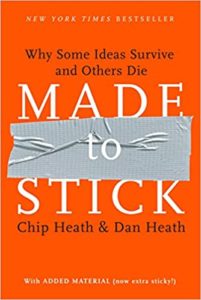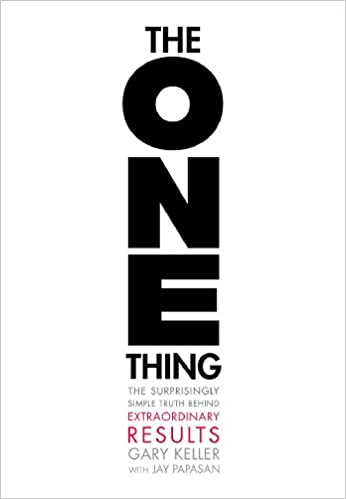
Book: Made to Stick: Why Some Ideas Survive, and Others Die
Authors: Chip Heath and Dan Heath
Year Published: 2007
Read More on Amazon
BOOK SUMMARY
TOPLINE
“Made to Stick” develops and reinterprets the ideas that Malcolm Gladwell had brought to the world in Tipping Point. The book seeks to explain what makes an idea or concept exciting and memorable. They use case studies and anecdotes to establish their arguments. In every chapter of the book, the authors use a case study to demonstrate the proof of their concept.
The books examine compelling business and personal stories to cull out six traits that make ideas or concepts stick in our brains.
Knowing these six principles can help you understand why ideas stick in your mind, as well as give you the knowledge to spread your ideas to the people you want to target.
BOOK SUMMARY
Let us begin with the counterpoint to Sticky ideas – What makes an idea non-sticky?
The authors, Chip Heath and Dan Heath call this the “Curse of Knowledge.” Simply put, once we acquire some knowledge or get to know something, we then find it extremely hard to imagine what it was like not to have had that knowledge or not to have known that thing.
Therefore, the person who has the idea finds it challenging to explain the concept to others who lack this original person’s frame of reference or context with the idea.
So, back to what does make an idea stick. The authors outline this in the form of an acronym of the word SUCCESs (albeit with the second S missing). Each alphabet in this acronym refers to a principle that makes an idea “sticky.”
- Simple – Get to the core of the idea by knowing what to exclude.
- Unexpected – The idea should have an element of surprise. It should engage the curiosity of people.
- Concrete – Make sure that the idea means the same thing to everyone in your audience. The idea should be able to be grasped vividly and remembered.
- Credible – A sticky idea needs to have credibility.
- Emotional – The idea should be able to make people feel something. They should be able to realize its importance.
- Stories – An idea needs a narrative, a story, to get people to understand and respond.
1: Simple
The very first step is to get to the core of your idea.
People will not remember 90% of what you tell them. Therefore to be sure that what you tell them gets through, you need to identify and communicate the critical one or two things that you want your audience to remember and just focus on those. Therefore to communicate well, we need to whittle an idea down to its bare essentials.
A military analogy that explains this point vividly is the idea of a Commander’s Intent (CI). This CI is the very simple distillation of the Commander’s statement in plain language. The CI appears on the top of every Military order.
A clear CI generates purposeful activity. It succinctly represents what the Commander wants the unit to achieve and why it matters. The CI provides clarity to the subordinates without too much amplifying detail that can confuse.
It is the simplicity of an idea that can have the incredible potential to change behavior. Simplicity in an approach is also about prioritization. The most impactful elements of the idea first, the detail later.
Share the core of the idea to motivate:
Simple ideas are compact and profound. The key to driving people with your idea is to make them apply the concept to decisions that they make. This application could require distilling a multi-faceted idea into a simple core concept that people can grasp quickly and easily.
The idea can be communicated through the use of memory flags, to tap into what people already know. Through using a generative analogy, or by embedding schemas in your communication. For example:
- Disney Park employees are not designated ‘staff,’ they are ‘cast members.’
- The core idea of SouthWest airlines is ‘The low-fare airline.’
- The ‘Hollywood Pitch’ technique: For example, To explain the movie Speed: it’s Die Hard on a bus. Alien: its Jaws on a spaceship. Etc.
Simple, short, and profound.
2: Unexpected
There are two parts to communicating an idea.
First – how do I get the attention of my target audience
Second – How to retain this attention
Getting attention for your idea – Surprise
Psychologically our brain is wired to be aware of changes. Therefore, the way to get attention is to break a pattern.
Once you have distilled to the core of your message, figure out what is counterintuitive and unexpected about the message?
The surprise in the idea should also make sense. Therefore, the surprise in the message should not be random. It should instead be about creating a surprise, followed by an ‘aha!’ moment.
Keeping People’s attention – Interest
A great way to retain the interest of people once you have got their attention through the element of surprise is the technique of using a Mystery story.
Mystery stories work with every genre of ideas. They keep people’s attention from drifting. We want the answer that the mystery alludes to – ‘what happens next’ – and that desire to find out whodunnit keeps us interested.
Having generated curiosity, you now have people who have a gap in knowledge. This gap is like having an itch with a need to scratch.
To visualize how the mystery story works: think of the Sony engineer who created the idea of a “pocket radio” or JFK and his idea of “a man walking on the moon.”
‘A pocket radio,’ and a ‘man on the moon’ – both ideas contain a surprise, but they also create a knowledge gap. How will a big radio fit into a pocket? How will a man ever walk on the moon?
There is a burning need to get information that can help people make sense of these exciting ideas.
Therefore, to get and hold interest: find and communicate the idea that contains a surprise. Look for knowledge gaps in people’s minds related to your idea.
Hold people’s attention through curiosity.
3: Concrete
How do you make your ideas clear? You do that by making the idea ‘concrete.’ For example, A V8 engine is concrete. “High performance” is abstract. In essence, to create an idea that is clear and concrete requires context and a common language that everyone in your target audience can understand.
Concrete language helps people, especially people, new to an idea, understand the concept. Abstraction, on the other hand, is the language that the expert will have comfort with.
To simplify: Don’t communicate an abstract concept; sell a prototype if you can. Don’t talk with statistics that could be perceived as abstract, communicate instead with concrete examples.
Examples of abstractions to avoid are metaphors and jargon. Try and use sensory language to convey your idea. Paint a vivid mental picture.
We may find it easier to keep our communications concrete if we define and personalize our target audience in terms of their specific needs and behavior as readers, students, or customers.
Concrete ideas are easy to understand and easy to remember. Sticky ideas tend to contain lots of concrete images and words.
It is not difficult to communicate in concrete terms. The challenge more often is that we slip into the expert mode of abstract thinking or speaking because we have lived with the idea for a long time (while the recipient of our communication has not!). This flaw is what the authors call the “Curse of Knowledge.”
4: Credible
What makes ideas believable? To explore that, we need to look at what it is that we do believe. We believe things because our parents or our friends believe in them. Or because it’s a rule set by an authority like the government.
Believable ideas have ‘internal credibility.’ Having credibility implies that the idea is logical and has no inherent contradiction.
Believable ideas also have ‘external credibility.’ This external credibility is validation that the idea has proof of authority.
When we communicate an idea, we have to remember that the modern citizen has developed a healthy skepticism for new ideas as he/she is drowning in message across devices. The critical question for them becomes, who is behind these messages, and should I trust them?
Therefore to communicate a sticky idea: it must be logical, and it must offer convincing proof with examples or statistics or by an authority. The authors make the case that sometimes anti-authority might be better than authority.
If you can, let people “try-before-they-buy” to prove to themselves that your idea is worthwhile.
You could develop Internal Credibility by using a testimonial or example that passes The Sinatra Test:
The Sinatra Test: In Frank Sinatra’s song, New York, New York, there is a line “If I can make it there, I can make it anywhere!”
The authors suggest that you should look for that one example that makes your idea appear entirely credible. As an example: if, as a security company, you managed to get the security contract for Fort Knox, then anything that you say about security would be credible.
Using statistics: Statistics by themselves don’t hold stickiness. Its when we contextualize the statistics that the statistics instantly develop impact and stickiness.
For example, in fundraising for a charity, you could communicate that “for the price of a cup of coffee a month, you can buy a dozen mosquito nets and save lives in Africa. This appeal would be much more persuasive than asking for say $100 to buy a dozen mosquito nets to save lives in Africa.
Statistics are to be used to illustrate a relationship. People will remember the relationship, not the number. The authors recommend that you should use statistics as input, not the output.
Testable Credentials: Asking your customers or potential customers to test a claim for themselves is a ‘testable credential.’ In the restaurant brand, Wendy’s advertising campaign of the 1980s, the claim in the commercials was “Where’s the Beef”?
The ads implied that the hamburgers at Wendy’s were larger than those of other burger restaurant chains. Any hamburger consumer could easily verify this claim. And customers did check!
Testable credentials are an enormously powerful technique to boost credibility, as they effectively allow your audience to ‘try before they buy.’
Anti-authority: Consider, for example, using a dying smoker to convey the point that smoking isn’t good for you. It causes cancer!
Compelling details provide credibility to the idea. Details help make a claim concrete and real. And, therefore, more believable.
5: Emotional
Sticky ideas, evoke emotions. They move us, and in doing this, they connect us to the idea. Mother Theresa is supposed to have said, “If I look at the mass, I will never act. If I look at the one, I will”.
Therefore, a sticky idea will focus on what people already care about or will create an association with something that they do care about.
What people tend to care about selfishly tends to be themselves. The task is to take people up the emotional ladder by appealing to who they may want to become—a better version of themselves.
John Caples, one of the great copywriters of all time, had a golden rule that still works! ‘First, try to get self-interest into every headline you write,’ then move beyond that to the basic benefits and basic emotional drivers (sex, greed, and fear).
Messages with an “emotion” component make people care. Emotions inspire people to take action.
To check the impact of using emotion in advertising, the charity, Save the Children, tested two ad campaigns. One ad focused on statistics about the problems of poverty in several African countries. The other ad campaign featured just one seven-year-old girl—the campaign with the seven-year-old girl raised twice as much money.
The use of statistics in communication makes us re-engage with our rational mind. The use of statistics tends to take away the emotion, our ability to feel.
‘Semantic Stretch’ and the power of association: How do we make people care about our messages?
Perhaps the most effective way to make people care is to help create an association between something that your audience does not as yet care about with something that they do care about.
According to research conducted at Stanford and Yale, a common characteristic of successful communication involves the exploration of concepts for their emotional associations.
The authors noted that once people find that an idea has an emotional hook, they tend to overuse that idea. The authors called this overuse of the idea – semantic stretch.
Appealing to Self-Interest: Ideas that work do so by appealing to what matters to people. Reliably, what matters to people is self-interest. Therefore getting people to care involves invoking their self-interest or WIIFY — “what’s in it for you?”
An appeal to “you” tends to be more personal and relevant to the self, rather than a more impersonal generic sort of appeal. The former is much more successful in invoking self-interest.
So, how do we make people care about our ideas? According to the authors, we simply need to move away from the purely rational, logical way of thinking and think in a way that has empathy for specific individuals. This involvement of empathy demonstrates that the idea that we want to convey is related to things that are important to our audience.
The best emotional appeals target both the person’s self-interest and their identities. The appeal is moreover not just to the people they are right now, but to who they would like to be.
6: Stories
A vital attribute of a sticky idea is that it can be narrated as a story. These stories typically would have a simple plot that people can relate to. Stories help burn the idea into the audience’s mind.
Historically we have had an affinity for stories. The best stories are retold countless times because they demonstrate ways in which people have used their wisdom to solve seemingly intractable problems. Stories are also very compelling as tools of learning.
The best stories are not those that you create from scratch. These are instead, the stories that you discover. Consider, for example, the power of the story of Jared for Subway. Jared lost 245 Pounds of weight by putting himself on a diet of Subway sandwiches. This story makes believable the claim of Subway that their sandwiches were low fat.
Stories tend to evoke entertainment. We are not passive listeners or observers when we hear a story. We tend to simulate the story that we hear.
Does mental simulation work? Yes, because we cannot visualize events of the story without involving the same parts of our brain that are involved in physical activity. Stories are, therefore, like flight simulators for the brain.
The Three Plots
Stories energize and inspire. They broadly contain three types of plots:
The Challenge Plot
This kind of story is the classic underdog story or a rags-to-riches story. David and Goliath is the timeless Challenge plot.
The challenge plot involves a protagonist overcoming incredible odds and succeeding. This overcoming of great odds is what makes challenge plots inspiring.
A challenge plot gets people to take action.
The Connection Plot
The connection plot involves a “Good Samaritan” who develops a relationship that surmounts a significant divide. This barrier surmounted could be a relationship across a racial, ethnic, or class divide or any other divide that involves crossing a wide chasm.
Connection plots inspire us in social ways. These stories help make people more tolerant and more positively inclined towards others.
A connection plot or reaching out appeals to our empathy.
The Creativity Plot
The Creativity plot is about a protagonist making a mental breakthrough. This kind of story works when a problem is solved in a creative new way, giving us a fresh perspective.
Stories by themselves tend to meet the criteria for making ideas sticky. Stories almost always tend to be concrete. They tend to contain elements of emotions. Good stories have surprising twists and turns. The challenge with the plot of a story can sometimes be ensuring simplicity.
The best thing you can do to get more people on board with your ideas is just to practice telling stories – every day.
RECOMMENDATION
I would recommend this book strongly. This book’s appeal covers a broad canvas. It helps explain what sticky ideas are. And how to communicate them with good storytelling.
This book would be an excellent read for the young salesperson who wants to do more than just sell stuff. It will be an equally great book to read for the 45-year-old technocrat who needs to develop a refined insight into sales and marketing.
Finally, this is an excellent book for and anyone in business who is not already practicing active communication through storytelling daily.
Links To The Authors Of The Book: Chip Heath and Dan Heath




